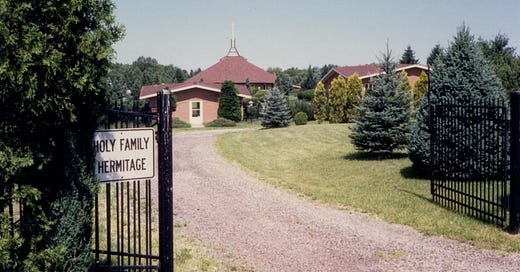“He will never be seen again,” writes Kevin Wells in his remarkable book titled The Hermit1 (Ignatius Press, 2024). He is writing about a Maryland priest named Martin Flum who has, in the author’s words, “crossed over the shores to another place, to what Homer called the wine-dark sea, where he has gone off to face the demons alone in the far countryside of solitude. He has buried himself in the ocean-wide depths of God's heart as a consecrated hermit. His home today is a cell, likely no larger than your childhood bedroom, buried deep in a forest, hidden among tens of thousands of trees.”
Father Flum is no longer a parish priest, he is now a hermit. The thing is, he was a hermit once before—and I encountered him in 2009.
I met him—or rather he met me—when I drove my car, weaving with wheels spinning in the deep snow, up a long and narrow tree-lined road, deep in the predawn woods of southeastern Ohio, during a winter storm.
It was December 27, 2009. I had arranged for a private, silent retreat at Holy Family Hermitage, a Camaldolese hermitage near Cadiz, Ohio, an hour or so from my home in Pennsylvania.
I had no idea how far into the woods I would travel before reaching the hermitage, but after a few nervous minutes, I saw a flickering light in the middle of the road a short distance ahead. It wasn’t a flashlight, but a lantern in the hands of a slender, bearded man covered in snow, standing next to a big, old, red, rusty farm tractor. He had been waiting for me. I immediately sensed something about this man. How long had he been standing in the cold, stormy weather, waiting for me?
He waved me to park. I got out of the car.
“You’re here for a retreat?” he asked.
“Yes.”
“You’re just in time for prime. Are you a priest?”
“No. Is that a problem?”
“No. Stand next to me in choir.”
And I did stand next to him in choir—side by side the eremite, in silence and in psalm—for matins and lauds, terce, vespers, compline, and Holy Mass. I was the sole retreatant and spent two days and two nights in the tiny retreat house. It never stopped snowing. I was restricted to the retreat house and the chapel nearby. It was an experience—the most solitude I ever had. Pray, read, write, repeat.
Holy Family has nine separate hermit cells. There were four living there at the time. One, a native of France, trudging through the snow, brought my meager meals on a tray, each with a most-welcome urn of coffee. French roast, I might add.
I had one lengthy conversation with Father Flum when he came to see if I had settled in. He was in his early 30s and had been a priest in the Archdiocese of Washington, DC when he discerned a call to the eremitical life. He asked Archbishop Donald Wuerl for permission to leave. Permission granted, he journeyed to southeastern Ohio.
Both afternoons we prayed the Rosary in a small, damp, dark, unheated room in the chapel building, our breath clouds rising with the prayers, visible in the soft winter sunlight that eked through the sole window. I worked the beads with my gloves; he had none. Images I’ve not forgotten.
I didn’t need Kevin’s book to remind me of the hermit, but was surprised to find that (1) Father Flum had left the Camaldolese to return to parish life, and (2) that he has discerned a second call to solitude—a reminder of the persistent uncertainty in our lives—but of this I am certain: late December, 2009 I was in the presence of a holy man in the person of “the hermit.”
On December 29, Feast of the Holy Innocents, he plowed me out of the long driveway. I lost sight of him as he waved goodbye from the seat of that old, red, rusty tractor.
And now it seems, the world has lost sight of him, too.
The book is subtitled The Priest Who Saved a Soul, a Marriage, and a Family. From the back cover: “In his raw and tender memoir, biographer Kevin Wells pulls readers into the unforgettable story of a parish priest turned hermit, Father Martin Flum, who orchestrated the slow resurrection of his wife, Krista, from the nightmare of her deep wounds and addiction.”




